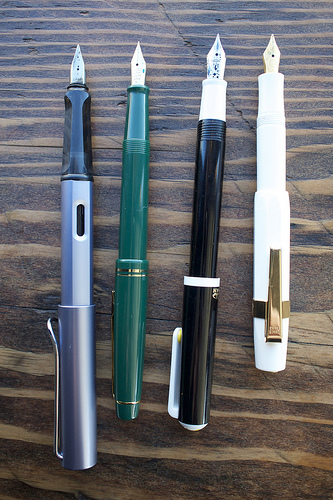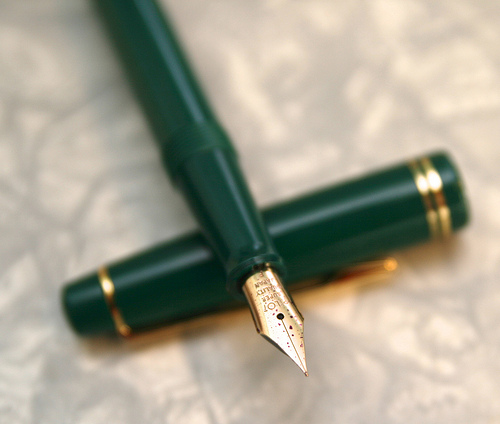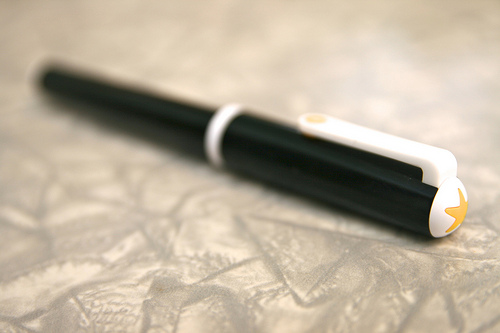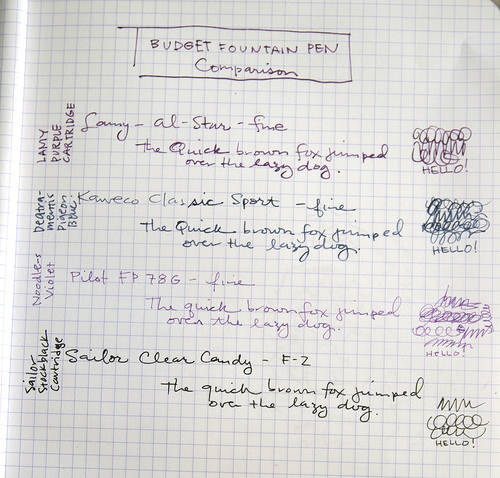Over the past couple of years, I’ve collected a small collection of modern, budget fountain pens. When I say budget, I mean under $50 and in most cases even under $25. Right now, this collection includes a Lamy Al-Star (a step up from the Lamy Safari with an aluminum rather than plastic body) ($45), Pilot FP 78g ($14, no longer available via Jet Pens but listed by several ebay sellers), Sailor “Clear Candy” ($16.50) and a Kaweco Classic Sport ($23.50).
All four fountain pens are listed as “F” (the Sailor is an “F-2” but listed as “Fine” on Jet Pens). As many other sites have mentioned, there is a difference between what Japanese pen manufacturers list as a fine nib and what European manufacturers list as a fine nib. Japanese nibs are much finer overall. The Lamy and the Sailor are silver steel nibs while the Kaweco and Pilot are gold are gold plated. The Kaweco has an iridium tip as well which makes it a super smooth writer.
Pilot FP 78g
By far, the Pilot FP 78g is the finest nib I’ve used. I would compare the nib size to a 0.3 or 0.4 gel pen. As a result, the Pilot can feel a bit scratchy on the paper but for such a fine point, that is probably to be expected. Overall I think the gold nib helps keep this pen flowing smoothly despite its fine nib size.
The overall look and size of the pen is probably the more consistent with what people imagine a fountain pen to look like with its gold stripes and clip and classic tapered lines. This could be a pen purchased in the 1950s or today.
The Pilot 78g comes with an aerometric filling mechanism, you squeeze the metal frame around the rubber sac to create suction to fill the sac. This is probably the most challenging methods to fill a pen and probably not recommended for someone’s first foray into fountain pens. The sac is black so its difficult to tell how full it is, if its full at all and if its been cleaned out properly. I think over time this could be potentially finicky, especially at the under $20 price point. Alternately, this is quite a nice writing tool at the price.
Kaweco Classic Sport
Many men I know complain about the size and weight of the Kaweco because of its short length. Even with the cap posted on the end when writing, the length of the pen in larger hands is short. Most women I know love the Kaweco as it is a lightweight, diminutive pen. For short notes and a portable fountain pen that easily fits in a pocket, the Kaweco is a pen I would recommend to just about anybody. I believe the folks over at Fountain Pen Geeks have mentioned that the Kaweco will need priming (scribble, scribble, scribble) to get it going if its been sitting overnight. Of these “fine nib” pens, I find the Kaweco the broadest, probably comparable to a 0.5 gel pen. Because of its diminutive size, the Kaweco is sold as a cartridge-only pen. While this is perfect for the first-time fountain pen buyer, if you are someone who has been bitten by the bug for lavish fountain pen inks, you will need to get creative to use them with a Kaweco. Thanks to a tip from Kathy at Letter Writers Alliance, I have been refilling old cartridges with various fountain pen inks using a Goulet Pens syringe.
Sailor “Clear Candy”
I suspect that Jet Pens is responsible for the “Clear Candy” name for this line of inexpensive fountain pens. Between the candy colors and the budget price point, I suspect that this line was designed as a school-grade fountain pen for the Japanese market. But that is no reason to dismiss this pen as a great entry level fountain pen. The pen comes with one Sailor-specific cartridge but for an additional $8.25 you can purchase the Sailor fountain pen converter which uses piston filling mechanism (twist the screw post to fill with ink). The steel nib is ever-so-slightly scritchy on paper but its writes consistently. I would compare the line width to a Pilot Precise V5. While I can’t seem to wax poetic about this pen, I do like it.
Lamy Al-Star
As the most expensive of the lot by budget pens standards, I expected a lot from the Lamy. This is the budget fountain pen I’ve owned the longest, going on three years, I think. It is the largest of the pens and the only one with a click cap mechanism (all the others have a threaded twist-off cap). It has a window cut into the sides to see the ink reserve which is convenient. The Lamy takes Lamy specific cartridges or can be used with the Lamy converter which also uses a piston mechanism.
The Lamy also features a grip that is grooved to help users hold it properly. This however is my least favorite aspect of the pen. As a leftie, my grip can be a little unconventional so this grip is actually more of a hindrance to its use than an improvement. I can still write with it without any problems its just that this grip is not comfortable for me in the long-term. I am purchasing a Lamy Studio which has a smooth rounded grip that I hope will be the key to winning me over to Lamy.
The steel nib is smooth and fairly consistent. Lamy nibs are offered in a wide array of widths from extra-fine to broad and there are even calligraphy nibs in 1.1mm, 1.5mm and 1.9 mm. Many fans have compared the 1.1mm calligraphy nib to the coveted vintage Esterbrook fine stub. Overall, this is the budget pen that most often gets recommended because of its larger size and many options.
Writing Sample
I just jotted out a few lines with each pen in whatever ink they were loaded with currently. This is by no means a thorough testing of each of these pens, the ink or the paper I used, I just wanted to be able to provide a visual comparison of the line weights. Notice how tiny I could write the word “Hello” with the Pilot FP 78g.
I did mislabel the ink used in the Kaweco, its actually a Kaweco blue-black cartridge.
In conclusion
Of all these pens, I consistently reach for the Kaweco. It is smooth and effortless on paper and fits in any pocket, purse or bag I choose to carry. I added the gold tone clip to match the logo which accentuates its vintage good looks. The Sailor tends to stay at work. Its nice enough to use everyday without looking too fancy for a staff meeting. The Lamy and the Pilot are least used at the moment. I think the Pilot is actually a tiny bit too fine for my taste (I never thought the day would come that I would type those words) and I’ve mentioned earlier my complaint with the grip on the Lamy.
** All pen tests are done by an over-writing left-handed writer. Yes, that’s right, all of these pens get the left-handed stamp of approval!








